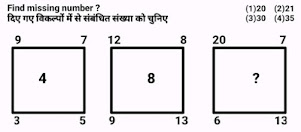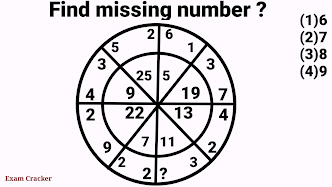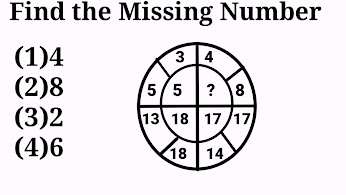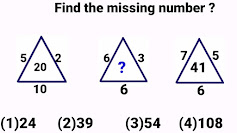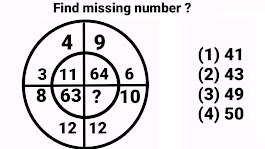Most important reasoning questions for competitive exams using reasoning tricks
I have explained ten most important reasoning questions of missing number for competitive exams like ssc cgl, ssc chsl ,bank clerk and rrb ntpc . These missing number Reasoning questions have been explained in simple language and easy style.
Important reasoning questions in figure problems
Problem #1
This reasoning problem consists of four figures and every figure have five numbers ,four around the figure and one in the centre of the figure. Watch carefully all the numbers which are around the central number are perfect squares. So we have to find out the square roots of these numbers and add these numbers then divide the sum with 5 to find the middle number ,
Middle number in every figure is 5th part of sum of roots of every the numbers
1st Figure
{√100 +√25 + √100 + √25 } ÷ 5 = {10 + 5 + 10 + 5 } ÷ 5 = 30 ÷ 5 = 6 ( Middle number in 1st figure )
2nd Figure
3rd Figure
4th Figure
Problem #2
1st Figure
2nd Figure
3rd Figure
Problem #3
Formula :-
1st Figure
2nd Figure
3rd Figure
Option (2)154 is correct option
Problem #4
Problem #5
These are given terms of series.
57, 56, 55, 51, 43, 34, ?
Differences of two consecutive terms can be calculated like this
57 - 56 = 1
56 - 55 = 1
55 - 51 = 4
51 - 43 = 8
43 - 34 = 9
34 - ? =
Now study the differences
1, 1, 4 , 8 , 9 , ....
This can be written as
1², 1³, 2², 2³, 3²,.....
In this pattern next difference would be 3³ and 4²
So next number would be 34 + 3³ = 34 + 27 = 61
And similarly next number would be 61 + 4² = 61 + 16 = 77
So question marks? = 61
57, 56, 55, 51, 43, 34, ?
Differences of two consecutive terms can be calculated like this
57 - 56 = 1
56 - 55 = 1
55 - 51 = 4
51 - 43 = 8
43 - 34 = 9
34 - ? =
Now study the differences
1, 1, 4 , 8 , 9 , ....
This can be written as
1², 1³, 2², 2³, 3²,.....
In this pattern next difference would be 3³ and 4²
So next number would be 34 + 3³ = 34 + 27 = 61
And similarly next number would be 61 + 4² = 61 + 16 = 77
So question marks? = 61









